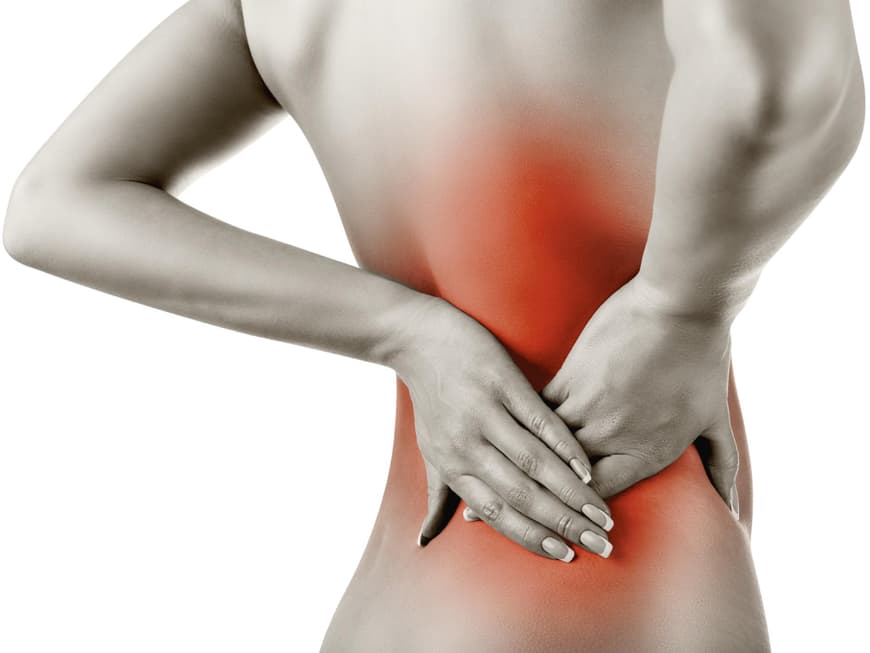
In the case of lumbago, also known as acute lumbalgia or acute lumbago, sufferers are suddenly hit by a sharp pain in the lumbar spine. The pain can radiate into the legs. The sufferer's freedom of movement is often restricted and they find it difficult to stand up. Numbness or signs of paralysis may also occur.
Lumbalgia: lower back pain and its causes
The causes of lower back pain are diverse and can vary depending on the clinical picture. It can also affect people of any age. Back pain often develops over a long period of time. Sometimes it is triggered by physical work or incorrect posture, incorrect strain or posture, tension, being overweight or short-term overloading of the back. Sometimes we make a wrong movement and suddenly experience pain.
Diseases such as herniated discs or lumbago are also causes of chronic back pain. Stress, incorrect footwear, an uncomfortable mattress or too little exercise can also cause pain. Unfortunately, the risk of pain also increases with age due to normal signs of wear and tear.
How can lumbar pain be treated?
It is important that those affected by back pain consult a doctor to get to the bottom of the causes of the pain. In this way, an individual diagnosis can be made and the doctor can initiate further treatment if necessary or refer the patient to a specialist.
Lumbalgia can have a variety of causes, depending on the diagnosis the sufferer has received from the doctor and whether it is an acute problem or chronic pain. In the case of acute lumbago, for example, the doctor may give a pain-relieving and anti-inflammatory injection to provide relief or administer painkillers. In the case of a slipped disc, patients are often initially given painkillers and anti-inflammatory medication to get rid of the acute pain. This is often followed by physiotherapy.
Lumbago: When is it better to see a doctor?
The symptoms often disappear on their own and can be treated with home remedies, for example. In certain cases, however, you should definitely consult a doctor. For example, if the pain in the lower back is persistent and/or even gets worse. The following also applies: If you experience symptoms of paralysis or numbness, you should see a doctor immediately!
SOS tips for lumbago can be found here >>
What helps against lumbalgia: Exercises and home remedies
Massages or ointments are effective against tension. Heat is also a tried and tested home remedy for pain. A nice hot bath, a hot water bottle or a grain pillow can provide relief. The so-called stepped position, where you lie flat on your back with your legs elevated, can also help to alleviate acute pain. Place your lower legs at right angles to your thighs on a surface that is as high as the length of your thighs. You can use the sofa or a suitable chair, for example.
The so-called "rolling up" should also help with acute complaints. To do this, lie flat on your back and pull your legs up. Wrap your arms around your legs below your knees and pull them towards your body. Hold the position for about 5 breaths, then put your legs down. Repeat if necessary. The exercise is designed to strengthen the back and gluteal muscles and stretch the muscles.
Integrate more movement into your everyday life
Exercise is always a good way to prevent pain, so you should try to move as much as possible in your everyday life. Here are our tips:
- Take the stairs instead of the elevator and walk a lot. For example, get off the train one stop before your destination and walk the rest.
- For shorter distances, take the bike instead of the car. This will keep you moving and protect the environment at the same time.
- Stand up more often in the office and walk around for a while, rotating your shoulders. A standing desk can also be helpful, as sitting down all the time is not good for your back.
- How about a back-friendly sport, such as swimming, aqua gymnastics, Nordic walking or yoga? Or attend a special back course. Physiotherapy can also be useful.
To prevent lumbar pain, we should therefore get enough exercise and strengthen the muscles in our back. It is also important to avoid stress, as this also promotes the development of back pain. Also make sure that you do not lift or carry anything too heavy.
Are there homeopathic remedies for lumbar pain?
Anyone can use homeopathic remedies themselves, as they are not available on prescription. According to Praxisvita.de, Castor Equi D6 is a proven homeopathic remedy for pain in the lumbar vertebrae. Five globules should be taken three times a day. If there is no improvement after 2 days, a doctor should be consulted. Another proven remedy for back pain is Arnica, for example in cases of physical overexertion or inflammation.
Which sexual position is suitable for back pain?
The riding position is ideal for men suffering from back pain. In this position, men don't have to make any thrusting movements, so there is less strain on the lumbar spine. Positioning a pillow under the back can provide additional support.
The spooning position is also suitable for lumbar pain - both men and women find it comfortable. Both men and women lie completely relaxed on their side and the back is not put under much strain in this position. Here too, pillows can provide additional relief.
Read also:
Blockage in the back: What to do
Yoga for the back
Tips for a strong back
